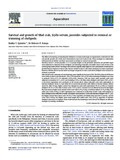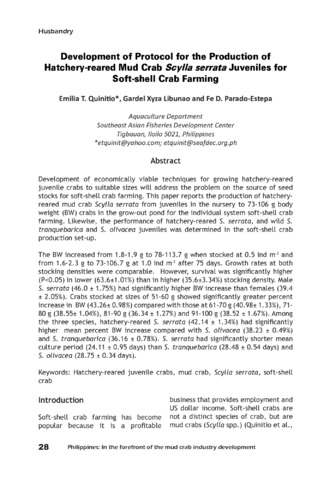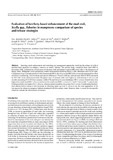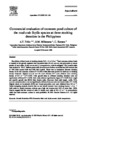Survival and growth of mud crab, Scylla serrata, juveniles subjected to removal or trimming of chelipeds

View/
Request this document
Date
2011Page views
298Metadata
Perlihat publikasi penuhCited times in Scopus
Share
Abstract
The effects of removing or trimming the chelipeds at various molt stages on regeneration, molt interval (MI) and specific growth rate (SGR) were determined in mud crab Scylla serrata. These strategies in combination with provision of shelters and food were tested in relation to survival and growth.
Hatchery-reared S. serrata juveniles (1.3–2.2 g body weight) in the postmolt, intermolt, and premolt stages were subjected to autotomy of two chelipeds, and trimming of dactylus and pollex. Intact crabs served as the control group. Interval from stocking to first molt was significantly longer in crabs autotomized at intermolt or premolt than in trimmed or intact crabs, but was similar to intact crabs when autotomy was done at postmolt. However, MI from first to second molts was longer compared to intact crabs when chelipeds were removed or trimmed at premolt.
After the first molt, autotomy and not trimming caused significant decrease in SGR. The SGRs at the end of the test were similar to intact crabs (postmolt: 7.90 ± 0.39, intermolt: 5.64 ± 0.50) when trimming of chelipeds was done at postmolt (8.01 ± 0.75) or intermolt (4.38 ± 0.40). However, SGR was lower when premolt crabs were subjected to autotomy (4.11 ± 0.67) and trimming (5.29 ± 1.40) than when chelipeds were intact (9.45 ± 0.47).
A two-factor experiment was conducted in the second phase where intermolt crabs with autotomized or trimmed chelipeds (factor A) were either fed or starved but provided with shelters or fed but without shelters (factor B). After 10 days, higher survival was obtained in crabs with autotomized (95.55 ± 2.94%) or trimmed chelipeds (93.33 ± 3.33%) than in intact crabs (73.33 ± 6.67%). Survival was not affected by factor B, but higher final mean body weights were attained in fed crabs with (0.78 ± 0.04 g) or without shelters (0.74 ± 0.04 g) than unfed ones (0.48 ± 0.04 g). A third experiment was conducted to verify these results. Crabs with trimmed or intact chelipeds were either fed or unfed. No shelters were provided. Crabs with trimmed chelipeds (88.57 ± 0%) had higher survival than intact crabs (59.76 ± 7.56%) regardless of whether they were fed or starved; and fed crabs (0.82 ± 0.04 g) had higher mean body weight than unfed crabs (0.61 ± 0.07 g) regardless of whether chelipeds were intact or trimmed. These results indicate that trimming or total removal of chelipeds are effective strategies in reducing cannibalism.
Suggested Citation
Quinitio, E. T., & Estepa, F. D. P. (2011). Survival and growth of mud crab, Scylla serrata, juveniles subjected to removal or trimming of chelipeds. Aquaculture , 318(1-2), 229-234. https://doi.org/10.1016/j.aquaculture.2011.05.034
Subject
autotomy  ; body weight
; body weight  ; bottom culture
; bottom culture  ; cannibalism
; cannibalism  ; crab fisheries
; crab fisheries  ; growth rate
; growth rate  ; juveniles
; juveniles  ; shelters; survival
; shelters; survival  ; moulting
; moulting  ; Decapoda
; Decapoda  ; Scylla serrata
; Scylla serrata 
 ; body weight
; body weight  ; bottom culture
; bottom culture  ; cannibalism
; cannibalism  ; crab fisheries
; crab fisheries  ; growth rate
; growth rate  ; juveniles
; juveniles  ; shelters; survival
; shelters; survival  ; moulting
; moulting  ; Decapoda
; Decapoda  ; Scylla serrata
; Scylla serrata 
Taxonomic term
Koleksi
- AQD Journal Articles [1240]
Related items
Showing items related by title, author, creator and subject.
-
Development of protocol for the production of hatchery-reared mud crab Scylla serrata juveniles for soft-shell crab farming
Quinitio, Emilia T.; Libunao, Gardel Xyza; Parado-Estepa, Fe D. (Aquaculture Department, Southeast Asian Fisheries Development Center, 2017)Development of economically viable techniques for growing hatchery-reared juvenile crabs to suitable sizes will address the problem on the source of seed stocks for soft-shell crab farming. This paper reports the production ... -
Evaluation of hatchery-based enhancement of the mud crab, Scylla spp., fisheries in mangroves: comparison of species and release strategies
Lebata, Ma. Junemie Hazel L.; Le Vay, Lewis; Walton, Mark E.; Biñas, Joseph B.; Quinitio, Emilia T.; Rodriguez, Eduard M.; Primavera, Jurgenne (CSIRO Publishing, 2009)Ranching, stock enhancement and restocking are management approaches involving the release of wild or hatchery-bred organisms to enhance, conserve or restore fisheries. The present study, conducted from April 2002 to ... -
Commercial evaluation of monosex pond culture of the mud crab Scylla species at three stocking densities in the Philippines.
Triño, Avelino T.; Millamena, Oseni M.; Keenan, C. (Elsevier, 1999)The effects of three levels of stocking density (0.5, 1.5 or 3.0 m−2) and monosex culture (male or female) on the growth, apparent feed conversion ratio (FCR), survival, and production of mixed species of mud ...




